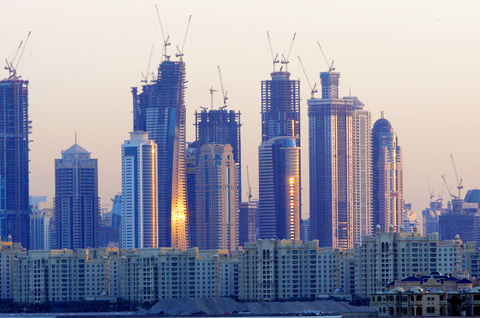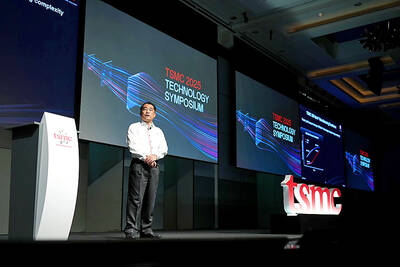Dubai’s request for a debt moratorium for its Dubai World conglomerate worried markets on Thursday, but the Gulf city state can count on Abu Dhabi, its deep-pocketed rich brother, to avoid default, analysts said.
“Dubai as a state ... is not on the verge of bankruptcy, thanks to the support of Abu Dhabi,” said Pascal Devaux, Middle East risk assessment economist at BNP Paribas.
Dubai is one of seven city states that make up the United Arab Emirates (UAE), along with Abu Dhabi. On Wednesday, it announced that it intends to request a “standstill” for at least six months on the maturing debt of Dubai World, its largest and most-indebted state-run holding.

PHOTO: REUTERS
That sent jitters through major world stock markets on fears of a potential default by Dubai, which has a total debt of around US$80 billion, mostly owed by state companies.
Standard and Poor’s estimated last month that Dubai state-related companies are due to repay some US$50 billion in debt over the next three years, which represent 70 percent of the emirate’s GDP.
The ratings agency said on Wednesday that Dubai World’s action amounts to a default and it downgraded companies in the group by several notches.
On the immediate horizon, Dubai World construction unit Nakheel was due to repay US$3.5 billion on Dec. 14 in the form of maturing Islamic bonds.
But although the picture appears bleak, Dubai’s oil-rich leading partner in the UAE, Abu Dhabi, is seen as likely to shore up the emirate.
“Abu Dhabi would not allow the financial collapse of Dubai,” Dubai-based analyst Ibrahim Khayat said.
But he said the UAE heavyweight, which sits on more than 90 percent of the federation’s oil reserves and owns the world’s largest sovereign wealth fund, might seek to bring Dubai under its control.
“Abu Dhabi could allow the weakening of Dubai within the framework of the competition between the two, but a collapse of Dubai would also affect Abu Dhabi,” Khayat said.
Monica Malik, from EFG-Hermes investment bank, pointed out that it is not just Dubai that would be affected.
“This announcement highlights the substantial headwinds facing the UAE economy,” she said.
Abu Dhabi has already come to Dubai’s help twice since the once-booming emirate was hit by the global crisis last autumn. The first time was in February, when the UAE central bank pumped US$10 billion into a support fund established by Dubai to deal with its mounting debt issue.
And on Wednesday, just a few hours before raising the specter of default, Dubai announced that it had raised another US$5 billion from two Abu Dhabi-controlled banks that subscribed fully to a new bond issue. Dubai had said it aimed to raise US$20 billion through its support fund.
“The fact that Dubai World requested to reschedule its debt at the time when Dubai raised US$5 billion means that either Dubai is in a catastrophic state or that the loan was conditioned to restructuring the whole group,” Devaux said.
“There is a competition between the two emirates. Maybe Abu Dhabi is taking the chance to put its hand on Dubai, taking advantage of the crisis,” he said.

DEMOGRAPHICS: Robotics is the most promising answer to looming labor woes, the long-term care system and national contingency response, an official said Taiwan is to launch a five-year plan to boost the robotics industry in a bid to address labor shortages stemming from a declining and aging population, the Executive Yuan said yesterday. The government approved the initiative, dubbed the Smart Robotics Industry Promotion Plan, via executive order, senior officials told a post-Cabinet meeting news conference in Taipei. Taiwan’s population decline would strain the economy and the nation’s ability to care for vulnerable and elderly people, said Peter Hong (洪樂文), who heads the National Science and Technology Council’s (NSTC) Department of Engineering and Technologies. Projections show that the proportion of Taiwanese 65 or older would

Nvidia Corp yesterday unveiled its new high-speed interconnect technology, NVLink Fusion, with Taiwanese application-specific IC (ASIC) designers Alchip Technologies Ltd (世芯) and MediaTek Inc (聯發科) among the first to adopt the technology to help build semi-custom artificial intelligence (AI) infrastructure for hyperscalers. Nvidia has opened its technology to outside users, as hyperscalers and cloud service providers are building their own cost-effective AI chips, or accelerators, used in AI servers by leveraging ASIC firms’ designing capabilities to reduce their dependence on Nvidia. Previously, NVLink technology was only available for Nvidia’s own AI platform. “NVLink Fusion opens Nvidia’s AI platform and rich ecosystem for

Taiwan Semiconductor Manufacturing Co (TSMC, 台積電) yesterday said it is building nine new advanced wafer manufacturing and packaging factories this year, accelerating its expansion amid strong demand for high-performance computing (HPC) and artificial intelligence (AI) applications. The chipmaker built on average five factories per year from 2021 to last year and three from 2017 to 2020, TSMC vice president of advanced technology and mask engineering T.S. Chang (張宗生) said at the company’s annual technology symposium in Hsinchu City. “We are quickening our pace even faster in 2025. We plan to build nine new factories, including eight wafer fabrication plants and one advanced

‘WORLD’S LOSS’: Taiwan’s exclusion robs the world of the benefits it could get from one of the foremost practitioners of disease prevention and public health, Minister Chiu said Taiwan should be allowed to join the World Health Assembly (WHA) as an irreplaceable contributor to global health and disease prevention efforts, Minister of Foreign Affairs Lin Chia-lung (林佳龍) said yesterday. He made the comment at a news conference in Taipei, hours before a Taiwanese delegation was to depart for Geneva, Switzerland, seeking to meet with foreign representatives for a bilateral meeting on the sidelines of the WHA, the WHO’s annual decisionmaking meeting, which would be held from Monday next week to May 27. As of yesterday, Taiwan had yet to receive an invitation. Taiwan has much to offer to the international community’s